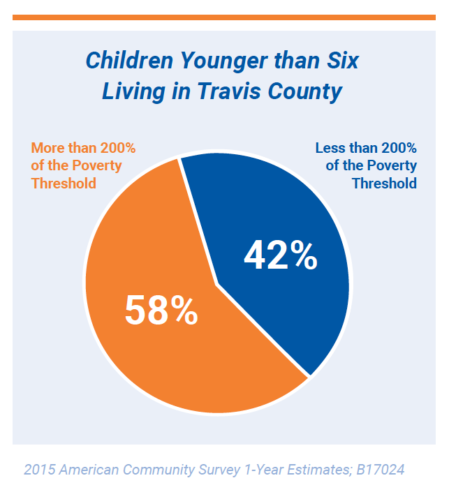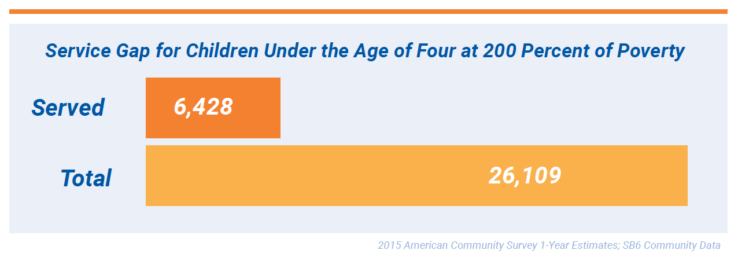“The number one way that we can address these long-term challenges of poverty, of education, is to invest in early childhood education.” – Julian Castro, Former United States Secretary of Housing and Urban Development
In 2012, United Way for Greater Austin brought early childhood advocates, experts, parents, service providers and business leaders together to transform the early childhood system in Travis County through a unified strategic plan – the School Readiness Action Plan (SRAP). The foundation for the SRAP was built on two decades of advocacy work by local early childhood champions as well as the science of early childhood development.
We recently updated the 2015-2018 SRAP. Here’s why this plan is so important.
Austin is a tale of two cities. On one hand, Austin is a vibrant city known for its live music and prosperous growth and, on the other side, Austin is the most economically segregated city in the nation and is growing in terms of wealth disparity.

And it’s our youngest residents who bear the brunt of economic disparities. More than 40 percent of all children under the age of six live in low-income households in Travis County. This means that almost 40,000 children do not have the same resources, support or opportunities as their counterparts from families with higher income.
The School Readiness Action Plan is built upon a clear framework. We believe that in order for children to be ready for success, families, communities, early-education services and physical and mental health professionals must be ready. They must have the skills, knowledge and resources to create a supportive environment for children to grow and stay developmentally on track.
Here’s how we’re helping
We believe that all children deserve to start out life on an even playing field. Our Success By 6 team works with a coalition of community stakeholders to create opportunities for low-income infants, toddlers and young children to receive high-quality education before they start kindergarten. As of 2016, we’ve seen the following improvements:
- The number of Texas Rising Star (TRS) 4-star rated, full-day, early care education centers with 20 percent of low-income children has increased from 34 to 46.
- The number of low-income children ages’ birth to 5 in TRS 4-star ranked early care centers has increased from 1,675 to 2,065.
- And lastly, the number of eligible 3-year-old children enrolled in public pre-k has increased by five percent in Travis County and other high-quality early education settings.
Our goal is for children and families to be informed. We want high-quality early learning environments to be accessible to all and to demonstrate positive developmental outcomes through competent responsive and caring relationships.
Where we see room for improvement
There are still so many gaps between low-income children and their higher-income counterparts. Due to the ever-increasing cost of housing in Austin, low-income families are being priced out of their neighborhoods and forced into outlying areas. Our data shows that between 2011 and 2015, the county’s rent and housing costs increased by 27 percent while the median household income increased by only 15 percent. Simply put, low-income families can’t afford to live in the city, let alone provide their children with high-quality early childhood education.

One of the most notable gaps is the gap in services available. Investments in life-changing interventions have decreased while the number of children in poverty has increased. In fact, there are 26,109 children under the age of four living at 200 percent of poverty in Travis County; only 6,428 of them are receiving any kind of early childhood education service.
In order to help more children become school ready by 2018 we have to close these gaps. We have to continue to invest in 2-Generation work that seeks to break the cycle of generational poverty through meeting the needs of both parents and children. We need to invest in high-quality early childcare centers to ensure that children don’t just have a safe place to stay while their parents work, but a safe place to learn and develop. We also need to invest in relationships between governmental and non-governmental entities as well as raise awareness for the services currently being offered.
We are striving to help families become financially secure and have access to resources to positively nurture their children. We fight for all children to have access to high-quality early education, physical and mental health care and a community that works together to deliver services to them that will aid in their long-term success.
The road to school readiness is long, but we are making an impact and every developed strategy and intervention gets us one step closer to our objective—a thriving community for all.
